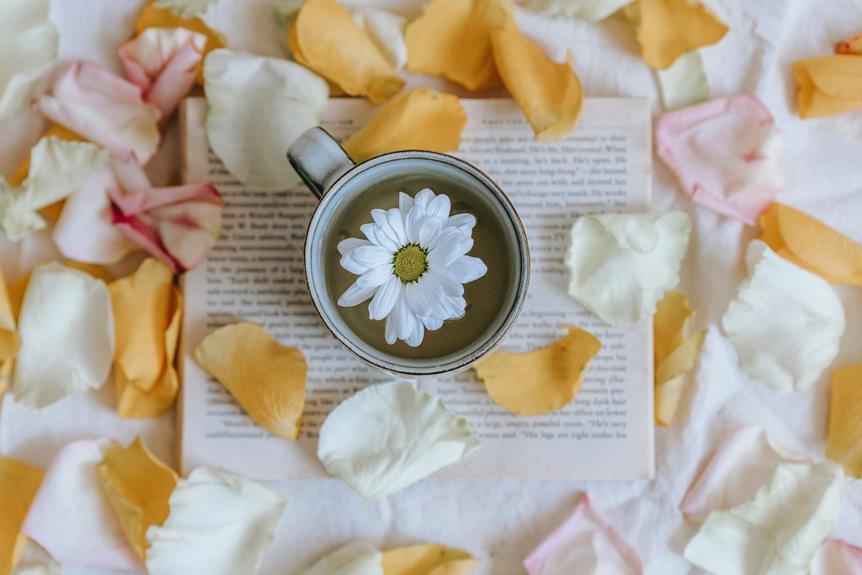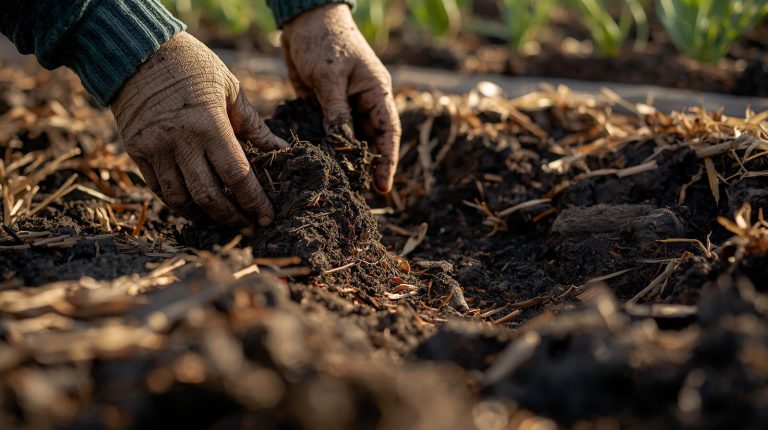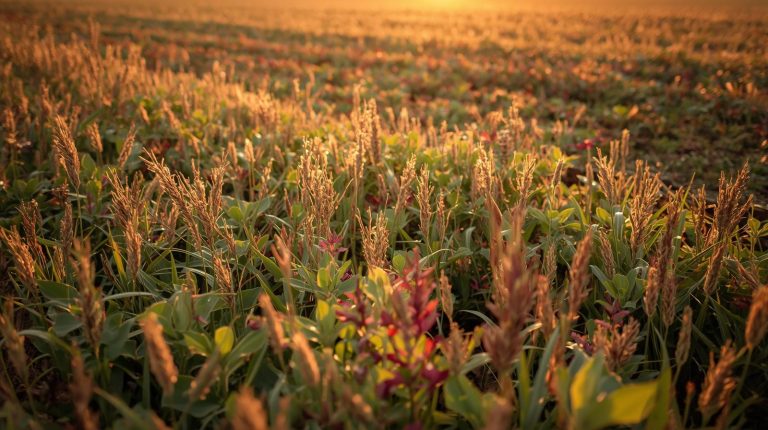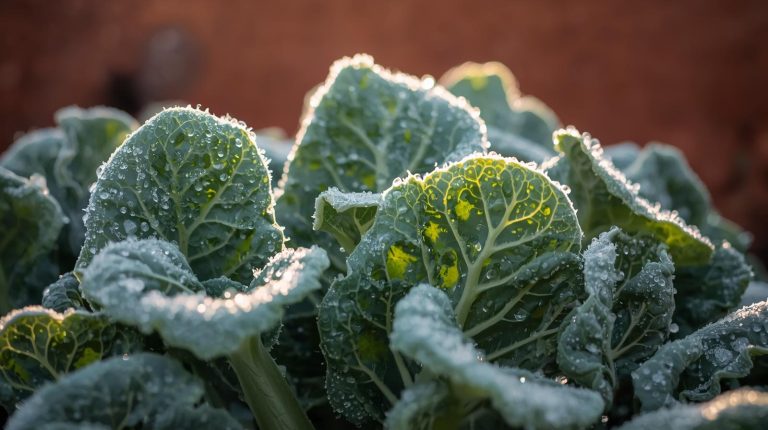Are you ready to transform your outdoor space into a lush and vibrant oasis? Look no further! We, your gardening enthusiasts, have curated a list of the top 14 plant and flower species for outdoor gardening. With these magnificent specimens, you can create a haven of beauty and serenity right in your own backyard.
From the classic elegance of roses to the cheerful radiance of sunflowers, each species on our list will bring a unique touch of nature to your outdoor sanctuary. So, whether you’re a seasoned gardener or just starting out, join us on this horticultural journey as we explore the captivating world of outdoor gardening.
Let’s embrace the beauty of nature together!
Roses
Roses are a popular choice of plant and flower species for outdoor gardening due to their vibrant colors and pleasant fragrance. These beautiful flowers belong to the genus Rosa and are part of the Rosaceae family. There are over 150 different species of roses, each with its own unique characteristics and care requirements. Some popular types of roses include hybrid teas, floribundas, grandifloras, climbers, and shrubs.
When caring for roses, it’s important to provide them with adequate sunlight, typically around 6 hours per day. They also require well-drained soil that’s rich in organic matter. Regular watering is essential, especially during hot and dry periods. Pruning is another important aspect of rose care, helping to promote healthy growth and remove any diseased or damaged branches.
To enhance the health and blooming of roses, it’s recommended to fertilize them regularly and provide proper pest and disease control. By following these rose care tips and understanding the different types of roses, gardeners can enjoy the beauty and fragrance of these beloved flowers in their outdoor spaces.
Sunflowers
Continuing our exploration of plant and flower species for outdoor gardening, let’s now turn our attention to sunflowers, a captivating addition to any garden. Sunflowers, scientifically known as Helianthus annuus, aren’t only visually stunning but also offer several benefits to gardeners.
Here are some sunflower benefits that make them a must-have in your garden:
- Vibrant and eye-catching blooms that add a pop of color to your outdoor space.
- Attract a wide variety of beneficial insects like bees and butterflies, promoting pollination and biodiversity.
- Provide a natural source of birdseed, attracting beautiful birds to your garden.
- Can be grown in different sizes, from dwarf varieties suitable for small gardens to towering giants for a dramatic effect.
- Easy to grow and care for, making them perfect for beginner gardeners.
To successfully grow sunflowers, consider the following planting tips:
- Choose a sunny location with well-drained soil.
- Sow sunflower seeds directly into the ground after the danger of frost has passed.
- Water regularly, especially during dry spells, to ensure proper growth.
- Provide support for taller varieties to prevent them from toppling over.
- Protect young sunflower plants from pests like slugs and snails.
With their captivating beauty and numerous benefits, sunflowers are sure to enhance any garden and create a sense of belonging to nature.
Tulips
Tulips are known for their vibrant color variations, ranging from deep reds and purples to bright yellows and pinks. When planting tulips, it’s important to choose a location with well-draining soil and full sun exposure.
To enhance the beauty of tulips in your garden, consider planting them alongside companion plants such as daffodils or hyacinths, which will provide a stunning display of colors and textures.
Tulip Color Variations
We can explore the diverse range of color variations found in tulips for outdoor gardening. Tulips come in a wide array of colors, making them a popular choice for adding vibrancy and beauty to any garden. Here are some stunning color variations to consider:
- Red: Classic and bold, red tulips create a striking focal point in any garden.
- Yellow: Symbolizing sunshine and joy, yellow tulips bring a cheerful and uplifting ambiance.
- Pink: Delicate and romantic, pink tulips add a touch of elegance and femininity.
- Purple: Regal and mysterious, purple tulips create a sense of enchantment in the garden.
- White: Pure and serene, white tulips evoke a sense of tranquility and purity.
By incorporating these different color variations into your tulip garden design, you can create a visually captivating and cohesive space. Remember to store tulip bulbs properly during the off-season to ensure their vitality and longevity.
Tulip Planting Techniques
To ensure successful growth and blooming, our tulip planting techniques involve proper soil preparation and strategic placement in the garden.
Before planting tulip bulbs, it’s important to store them correctly. Tulip bulbs should be stored in a cool and dry place, with a temperature between 40 to 45 degrees Fahrenheit. This helps maintain their quality and viability.
When it comes to planting depth, tulip bulbs should be planted at a depth of about 6 to 8 inches. This ensures that the bulbs are adequately covered and protected. Planting at the correct depth also helps prevent the bulbs from drying out or becoming exposed to extreme temperatures.
Following these tulip planting techniques will help ensure healthy growth and vibrant blooms in your garden.
Best Tulip Companion Plants
Let’s explore some excellent companion plants that pair well with tulips in outdoor gardens. When planning a tulip garden, it’s important to consider the surrounding plants that can enhance the beauty of the tulips and create a harmonious garden design. Here are five tulip companion plants to consider:
- Daffodils (Narcissus): These bright and cheerful flowers complement tulips perfectly with their vibrant colors and early blooming time.
- Grape Hyacinths (Muscari): These small, bell-shaped flowers create a stunning contrast when planted alongside tulips, adding a touch of blue or purple to the garden.
- Siberian Squill (Scilla siberica): These delicate blue flowers make an excellent companion for tulips, as they bloom at the same time and create a stunning carpet of blue in the garden.
- Forget-Me-Nots (Myosotis): These charming blue flowers add a touch of whimsy to any tulip garden and create a beautiful backdrop for the tulips.
- Pansies (Viola tricolor): With their wide range of colors and compact growth habit, pansies make an excellent companion for tulips, adding a splash of color and texture to the garden.
Lavender
Lavender is a popular plant known for its soothing aroma and numerous benefits. Growing lavender in outdoor gardens not only adds beauty to the landscape, but it also attracts pollinators and repels pests.
To cultivate lavender successfully, it’s important to choose the right variety, provide well-drained soil, and ensure proper sunlight and water requirements are met.
Lavender’s Soothing Aroma
We have discovered that the fragrance of lavender is undeniably soothing. Lavender’s therapeutic benefits are well-known, making it a popular choice for aromatherapy. The aroma of lavender has a calming effect on the mind and body, reducing stress and promoting relaxation.
In addition to its therapeutic benefits, lavender also has culinary uses. Its delicate floral flavor adds a unique twist to both sweet and savory dishes.
Here are five reasons why lavender’s soothing aroma is a must-have in your outdoor garden:
- Lavender promotes better sleep by helping to induce a sense of serenity and tranquility.
- The scent of lavender can alleviate anxiety and improve mood, creating a sense of well-being.
- Lavender’s aroma acts as a natural insect repellent, keeping pesky bugs at bay.
- The fragrance of lavender can help relieve headaches and migraines, providing much-needed relief.
- Lavender’s soothing aroma is a wonderful addition to homemade beauty products, such as bath oils and lotions, creating a spa-like experience.
With its therapeutic benefits and culinary versatility, lavender’s soothing aroma is a valuable addition to any outdoor garden.
Benefits of Growing Lavender
Growing lavender in your outdoor garden offers numerous benefits.
Lavender oil, derived from the flowers of lavender plants, has been used for centuries for its various therapeutic properties. One of the key benefits of lavender oil is its calming effect on the mind and body. It has been shown to reduce anxiety, promote relaxation, and improve sleep quality.
In addition to its aromatic properties, lavender has several other uses. It can be used in cooking to add a unique flavor to dishes, and it can also be used to make natural beauty and skincare products.
Furthermore, lavender plants attract pollinators like bees and butterflies, making them beneficial for the overall health of your garden.
Tips for Cultivating Lavender
To cultivate lavender successfully in your outdoor garden, it’s essential to follow these tips and techniques for optimal growth:
- Choose the right location: Lavender thrives in full sun and well-drained soil. Ensure the planting area receives at least 6 hours of sunlight daily.
- Prepare the soil: Lavender prefers slightly alkaline soil with a pH between 6.5 and 7.5. Improve drainage by adding organic matter like compost or sand.
- Planting: Space lavender plants 12 to 18 inches apart to allow for air circulation. Dig a hole slightly larger than the root ball and gently place the plant, ensuring it’s at the same level as the surrounding soil.
- Watering: Lavender is drought-tolerant and requires minimal watering. Water deeply but infrequently to promote deep root growth.
- Pruning: Regular pruning helps maintain the plant’s shape and stimulates new growth. Trim back about one-third of the plant after it finishes blooming.
In addition to its beauty, lavender is known for its versatile essential oil uses.
Daffodils
Daffodils are popular spring-blooming flowers in outdoor gardens. They’re known for their vibrant colors and trumpet-shaped blooms. Daffodils belong to the genus Narcissus and are native to Europe, North Africa, and parts of Asia.
There are numerous daffodil varieties available, each with its own unique characteristics. Some popular varieties include ‘Ice Follies’ with its white petals and yellow cup, ‘Tête-à-Tête’ with its bright yellow blooms, and ‘Pink Charm’ with its pink and white petals.
When it comes to daffodil care, they prefer well-drained soil and full sunlight. Plant the bulbs in the fall, about 6 inches deep and 4 to 6 inches apart. Water them regularly during the growing season and deadhead the flowers to promote new growth.
With proper care, daffodils can bring beauty and joy to any outdoor garden.
Marigolds
Continuing our exploration of outdoor gardening, let’s now delve into the world of marigolds. Marigolds are a popular choice for gardeners due to their vibrant colors and easy cultivation. Here are some key points to consider when growing marigolds:
- Marigolds come in various color variations, including shades of yellow, orange, and red.
- They thrive in well-drained soil and require full sun exposure.
- Marigolds are known for their ability to repel pests such as aphids and nematodes, making them a natural insect deterrent in the garden.
- Deadheading, the removal of spent flowers, promotes continuous blooming throughout the season.
- Marigolds can be grown from seeds or transplanted as seedlings.
Peonies
Moving on from marigolds, let’s now delve into the world of peonies, a stunning flower species for outdoor gardening.
Peonies, scientifically known as Paeonia, are herbaceous perennial plants that belong to the family Paeoniaceae. They’re native to Asia, Europe, and Western North America.
Peonies are highly valued for their large and showy blooms, which come in a variety of colors such as white, pink, red, and yellow. When it comes to peonies care, they prefer full sun to light shade and well-drained soil. Regular watering is essential, especially during dry periods, but overwatering should be avoided to prevent root rot.
There are three main types of peonies: herbaceous, tree, and intersectional. Each type has its own unique characteristics and growing requirements.
With proper care and attention, peonies can thrive and provide a beautiful addition to any outdoor garden.
Dahlias
When it comes to caring for dahlias, there are a few key tips to keep in mind. These include providing them with full sun, well-drained soil, and regular watering. Additionally, it’s important to stake or support the plants as they grow to prevent them from toppling over.
Dahlia Care Tips
To ensure the successful growth and blooming of dahlias in your outdoor garden, proper care is essential. Here are some key tips to help you maintain healthy dahlias:
- Pruning Techniques: Regularly prune your dahlias to encourage bushier growth and more blooms. Remove any dead or damaged stems, as well as any weak or crowded ones. Cut the stems just above a leaf node to promote new growth.
- Propagation Methods: Dahlias can be propagated through division or by taking cuttings. To divide dahlias, dig up the tubers in early spring or late fall, making sure each division has at least one bud. Cuttings can be taken from healthy, non-flowering shoots in spring. Place the cuttings in a well-draining soil mix and keep them in a warm, humid environment until they root.
- Watering: Dahlias need regular watering, especially during dry spells. Water deeply, ensuring the soil is moist but not waterlogged. Mulching around the plants can help retain moisture.
- Fertilizing: Feed your dahlias with a balanced fertilizer once a month during the growing season. This will provide them with the nutrients they need for healthy growth and abundant blooms.
- Disease and Pest Control: Keep an eye out for common dahlia pests like aphids, slugs, and snails. Use organic pest control methods or insecticides if necessary. Also, be vigilant for diseases like powdery mildew or black spot. Remove any infected leaves and apply fungicides if needed.
Popular Dahlia Varieties
Now, let’s dive into the world of popular dahlia varieties, where we frequently encounter a stunning array of colors and shapes that never fail to captivate gardeners.
Dahlias come in a wide range of colors, from vibrant reds and oranges to soft pinks and purples. Some popular dahlia colors include ‘Cafe au Lait’ with its creamy beige petals, ‘Bishop of Llandaff’ with its deep red blooms, and ‘Blue Bell’ with its delicate lavender flowers.
When it comes to arranging dahlias, the possibilities are endless. You can create a vibrant bouquet by combining different colors and sizes of dahlias or create a monochromatic arrangement for a more sophisticated look.
Dahlias also make stunning focal points in garden beds or can be used to add pops of color to borders and containers. Get creative and experiment with different dahlia arrangement ideas to bring beauty and elegance to your outdoor space.
Growing Dahlias Successfully
We have found that growing dahlias successfully requires providing them with proper care and attention. Here are some key tips for successful dahlia cultivation and using dahlias for cut flowers:
- Choose the right location: Dahlias thrive in full sun and well-drained soil. Select a spot in your garden that receives at least six hours of direct sunlight daily.
- Prepare the soil: Before planting, amend the soil with organic matter to improve drainage and fertility. This will provide the necessary nutrients for healthy growth.
- Planting depth: When planting dahlia tubers, ensure they’re placed at a depth of about 6-8 inches. This will promote strong root development and prevent tubers from drying out.
- Watering: Dahlias require regular watering, especially during dry periods. Water deeply, ensuring the soil is consistently moist but not waterlogged.
- Support and staking: Dahlias can grow tall and heavy, so provide support by staking them. This will prevent bending or breaking of stems and ensure the plants stay upright.
Hydrangeas
Among the top 14 plant and flower species for outdoor gardening, one that stands out is the hydrangea. Hydrangeas are beloved for their beautiful blooms and ability to thrive in a variety of climates. When it comes to hydrangea care, it’s important to provide them with well-draining soil and regular watering. These plants also benefit from occasional fertilization to promote healthy growth.
One of the most fascinating aspects of hydrangeas is their ability to change color based on the soil pH. Acidic soil produces blue flowers, while alkaline soil produces pink flowers. In addition to these color variations, some hydrangea varieties also produce white, purple, or even multicolored blooms.
With their stunning flowers and relatively low maintenance requirements, hydrangeas are a popular choice among gardeners looking to add a touch of beauty to their outdoor spaces.
Pansies
Pansies are an excellent choice for vibrant gardens due to their versatility and colorful blooms. These flowers come in a wide range of hues, including shades of purple, yellow, orange, and white, allowing for endless possibilities when it comes to creating eye-catching displays.
Additionally, pansies are known for their ability to withstand both cool and warm weather, making them suitable for various climates and seasons.
Pansies for Vibrant Gardens
With their vibrant colors and delicate petals, pansies add a burst of beauty to outdoor gardens. Pansies aren’t only stunning but also versatile, making them perfect for container gardening. Their compact size and shallow root system make them ideal for planting in pots, window boxes, or hanging baskets. Pansies are also resilient, thriving even in colder temperatures, making them a great choice for winter gardens.
Here are five reasons why pansies are a must-have for vibrant gardens:
- Pansies come in a wide range of colors, from deep purples and blues to bright yellows and oranges, allowing for endless possibilities in garden designs.
- These flowers have a long blooming season, providing continuous beauty throughout the spring, summer, and fall.
- Pansies are known for their charming ‘faces,’ with distinct markings on their petals that resemble human features, adding whimsy to any garden.
- They’re low maintenance, requiring minimal watering and fertilization, making them suitable for busy gardeners.
- Pansies attract beneficial insects like bees and butterflies, promoting a healthy ecosystem and biodiversity in the garden.
Pansies: Versatile and Colorful
We find that pansies are incredibly versatile and add a vibrant burst of color to any outdoor garden.
Pansies aren’t only beautiful but also make excellent choices for container gardening. Their compact size and wide range of colors allow them to be easily planted in containers, adding a stunning focal point to patios, balconies, or even windowsills.
Pansies are also ideal for ground cover, as they spread quickly and provide a dense carpet of color. Their low-growing habit and ability to thrive in both sun and partial shade make them suitable for various areas in the garden.
Whether used in containers or as ground cover, pansies are a perfect choice for gardeners looking to add a touch of versatility and vibrancy to their outdoor spaces.
Geraniums
One of the most popular plant and flower species for outdoor gardening is the vibrant and versatile geranium. Geraniums are known for their beautiful blooms and their ability to thrive in various climates and soil conditions. They’re low-maintenance plants that require minimal care, making them ideal for both beginner and experienced gardeners.
Here are some key points to consider when it comes to geranium care:
- Geraniums prefer well-drained soil and should be watered regularly, but not excessively.
- They thrive in full sun but can also tolerate partial shade.
- Deadheading spent blooms promotes continuous flowering.
- Geraniums can be propagated through stem cuttings or by dividing mature plants.
- There are many different varieties of geraniums available, including zonal, ivy-leaved, and scented varieties, each with their own unique characteristics and growing requirements.
With their vibrant colors and versatility, geraniums are a must-have addition to any outdoor garden.
Lilies
The next plant species that deserves our attention in this article on the top 14 plant and flower species for outdoor gardening is the elegant and captivating lily.
Lilies are a diverse group of flowering plants belonging to the genus Lilium. With over 100 different types, lilies come in a wide range of colors, shapes, and sizes, making them a popular choice among gardeners.
From the vibrant Asiatic lilies to the fragrant and showy Oriental lilies, there’s a lily variety to suit every garden.
To ensure the optimal growth and blooming of lilies, it’s essential to provide them with the right care. Lily care tips include planting in well-draining soil, providing adequate sunlight, regular watering, and fertilizing.
Petunias
Moving on from lilies, let’s now explore the vibrant and versatile petunias in our discussion of the top 14 plant and flower species for outdoor gardening.
Petunias are a popular choice among garden enthusiasts due to their stunning beauty and easy care requirements. Here are some key points to consider when caring for petunias:
- Planting Techniques: Petunias thrive in well-drained soil with a pH range of 5.5 to 7.5. Ensure they receive full sun exposure for at least six hours a day.
- Color Variations: Petunias come in a wide range of colors, including vibrant shades of pink, purple, red, white, and yellow. Choose a color palette that suits your garden’s aesthetic.
- Watering and Fertilizing: Water petunias regularly, keeping the soil consistently moist but not waterlogged. Use a balanced fertilizer every two weeks to promote healthy growth.
- Deadheading: Remove faded flowers regularly to encourage continuous blooming.
- Pest and Disease Control: Keep an eye out for common pests like aphids and slugs. Treat any signs of disease promptly to prevent further damage.
Orchids
So, how can we care for orchids in our outdoor garden?
Orchids are a popular choice of plant and flower species for outdoor gardening due to their stunning beauty and unique flower shapes. There are several popular varieties of orchids that thrive in outdoor conditions, such as Cymbidiums, Dendrobiums, and Epidendrums.
When it comes to caring for orchids, it’s important to provide them with the right conditions. They prefer bright but indirect sunlight, so placing them under a shade cloth or in a partially shaded area is ideal. Orchids also require well-draining soil, regular watering, and a balanced fertilizer.
It’s important to note that different orchid varieties have different care requirements, so it’s essential to research and understand the specific needs of the orchid species you choose to grow in your outdoor garden.
Conclusion
The plant and flower species for outdoor gardening mentioned in this article are sure to bring beauty and joy to any garden. Just like a well-orchestrated symphony, these vibrant blooms harmonize together, creating a visual masterpiece that can uplift the spirits of anyone who beholds it.
So, let your garden be a symphony of colors and fragrances, with roses and tulips taking the lead, while sunflowers and lavender add their own unique notes. Embrace nature’s symphony and let your garden become a sanctuary of tranquility and delight.




